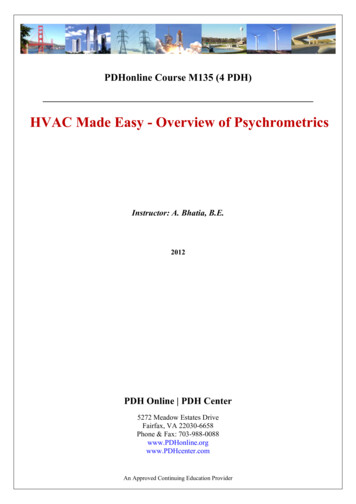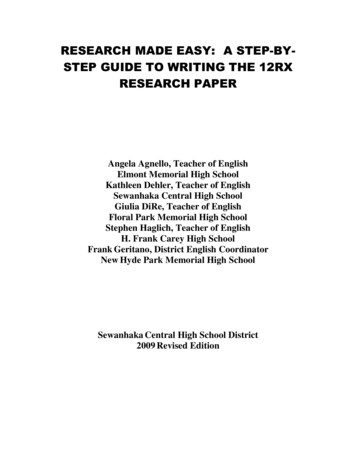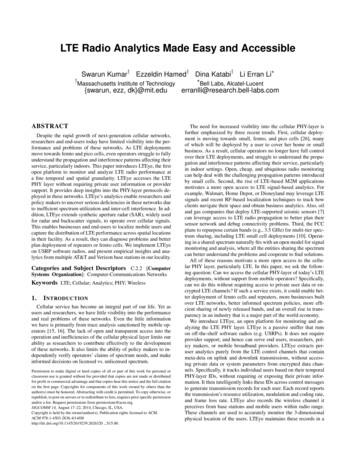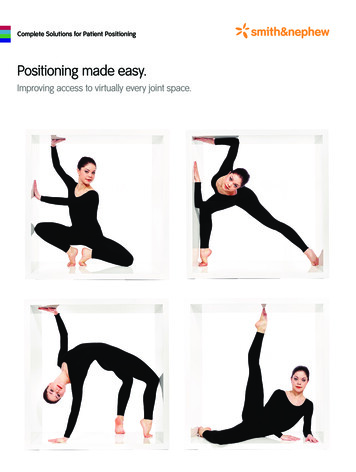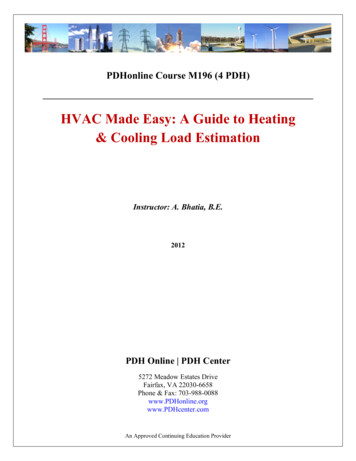
Transcription
PDHonline Course M196 (4 PDH)HVAC Made Easy: A Guide to Heating& Cooling Load EstimationInstructor: A. Bhatia, B.E.2012PDH Online PDH Center5272 Meadow Estates DriveFairfax, VA 22030-6658Phone & Fax: 703-988-0088www.PDHonline.orgwww.PDHcenter.comAn Approved Continuing Education Provider
www.PDHcenter.comPDH Course M196www.PDHonline.orgHVAC Made Easy: A Guide to Heating & Cooling Load EstimationCourse ContentAIR CONDITIONING SYSTEM OVERVIEWCooling & heating load calculations are normally made to size HVAC (heating, ventilating, and air-conditioning) systemsand their components. In principle, the loads are calculated to maintain the indoor design conditions. The first step inany load calculation is to establish the design criteria for the project that involves consideration of the building concept,construction materials, occupancy patterns, density, office equipment, lighting levels, comfort ranges, ventilations andspace specific needs. Architects and other design engineers converse at early stages of the project to produce designbasis & preliminary architectural drawings. The design basis typically includes information on:1) Geographical site conditions (latitude, longitude, wind velocity, precipitation etc.)2) Outdoor design conditions (temperature, humidity etc)3) Indoor design conditions4) Building characteristics (materials, size, and shape)5) Configuration (location, orientation and shading)6) Operating schedules (lighting, occupancy, and equipment)7) Additional considerations (type of air-conditioning system, fan energy, fan location, duct heat loss and gain, ductleakage, type and position of air return system )Climate data requirementsOne of the most important things in building HVAC design is the climate you are designing. Let’s make first distinction interms “weather” and “climate”."Weather" is the set of atmospheric conditions prevailing at a given place and time. "Climate" can be defined as theintegration in time of weather conditions, characteristics of a certain geographical location. At the global level climatesare formed by the differential solar heat input and the uniform heat emission over the earth's surface.Climate has a major effect on building performance, HVAC design and energy consumption. It is also pertinent to theassessment of thermal comfort of the occupants. The key objectives of climatic design include:1) To reduce energy cost of a building2) To use "natural energy" as far as possible instead of mechanical system and power3) To provide comfortable and healthy environment for peopleClassification of climatesMany different systems of climate classification are in use for different purposes. Climatic zones such as tropical, arid,temperature and cool are commonly found for representing climatic conditions. For the purposes of building design asimple system based on the nature of the thermal problem in the particular location is often used.1) Cold climates, where the main problem is the lack of heat (under heating), or excessive heat dissipation for all ormost parts of the year.2) Temperate climates, where there is a seasonal variation between under heating and overheating, but neither isvery severe.3) Hot-dry (arid) climates, where the main problem is overheating, but the air is dry, so the evaporative coolingmechanism of the body is not restricted. There is usually a large diurnal (day - night) temperature variation.Page 1 of 79
www.PDHcenter.comPDH Course M196www.PDHonline.org4) Warm-humid climates, where the overheating is not as great as in hot-dry areas, but it is aggravated by very highhumidity’s, restricting the evaporation potential. The diurnal temperature variation is small.Six categories of climates:1) Warm-humid - 15 N and South of the equator, e.g. Lagos, Mombassa, Colombo, Jakarta etc.2) Warm-humid Island - equatorial and trade wind zones, e.g. Caribbean, Philippines and Pacific Islands etc.3) Hot-dry desert - 15 to 30 North and South, e.g. Baghdad, Alice Springs, Phoenix etc.4) Hot-dry maritime desert - latitudes as (3), coastal large landmass, Kuwait, Karachi etc.5) Composite Monsoon - Tropic Cancer/Capricorn, Lahore, Mandalay, New Delhi etc.6) Tropical uplands - Tropic Cancer/Capricorn, 900 to 1200 meters above sea level (plateau and mountains), AddisAbaba, Mexico City, Nairobi etc.Load Calculations MethodsBefore one can design an efficient and effective air conditioning system, the load must first be calculated usingestablished techniques. There are various methods in use. The most basic of these methods is a rule-of-thumb value -for example, square feet of floor area per ton of cooling. The "square-foot-per-ton" sizing method avoids calculating thecooling load of the building and proceeds directly from the square footage of the building. While this approach is rapidand simple, it does not account for orientation of the walls and windows, the difference in surface area between a onestory and a two-story home of the same floor area, the differences in insulation and air leakage between differentbuildings, the number of occupants, and many other factors. Such rules-of-thumb are useful in schematic design as ameans of getting an approximate handle on equipment size and cost.The more refined methods available in the HVAC handbooks are:1) Total Equivalent Temperature Difference/Time Average (TETD/TA)2) Cooling Load Temperature Difference/Cooling Load Factor (CLTD/CLF)3) Transfer Function Method (TFM)4) Heat Balance (HB) & Radiant Time Series (RTS)5) Manual J Method for Residential Applications & Manual N for Commercial Buildings: These methods are simplifiedversions, jointly developed by Air conditioning contractors of America (ACCA) and the Air conditioning andRefrigeration Institute (ARI).These different methods may yield different results for the same input data. This is primarily due to the way; eachmethod handles the solar effect and building dynamics. But in true sense all the above approaches attempt to considerthe fundamental principle that heat flow rates are not instantaneously converted to loads and heat addition or extractionincident upon the building do not immediately result in a change in temperature. Thermally heavy buildings caneffectively delay the cooling or heating load for several hours.Most designers use the TETD and CLTD methods because these methods are simple to use, give component loadsand tend to predict load on conservative side. The most recent versions of the ASHRAE Fundamentals Handbook(2001) provide more detailed discussion on the Radiant Time Series (RTS) and Heat Balance (HB) methods. The HeatBalance method is the most accurate but is very laborious and cumbersome and is more suitable with the use ofcomputer programs. The RTS is a simplified method derived from heat balance (HB) method and effectively replacesall other simplified (non-heat balanced) methods.For strictly manual cooling loads calculation method, the most practical to use is the CLTD/CLF method. This coursediscusses CLTD/CLF method in detail in succeeding sections.A number of handbooks provide a good source of design information and criteria to use for CLTD/CLF method;however engineering judgment is required in the interpretation of various custom tables and applying appropriatecorrection factors. It is not the intent of this course to duplicate information but rather to provide a direction regarding theproper use or application of the available data so that the engineers and designers can make an appropriate decision.Page 2 of 79
www.PDHcenter.comPART 1PDH Course M196www.PDHonline.orgSUMMER COOLING LOADPrefaceThe term summer cooling load means much more than merely cooling the air in a building. In addition to cooling the air,it also implies controlling:1) The relative humidity2) Providing proper ventilation3) Filtering out contaminants (air cleaning) and4) Distributing the conditioned air to the lived-in spaces in proper amounts, without appreciable drafts or objectionablenoiseThis section deals with the design aspects and the equations used for summer cooling load calculations.Design ConditionsThe amount of cooling that has to be accomplished to keep buildings comfortable in hot summer depends on thedesired condition indoors and on the outdoor conditions on a given day. These conditions are, respectively, termed the“indoor design condition” and the “outdoor design condition”.Indoor Design ConditionsThe indoor design conditions are directly related to human comfort. Current comfort standards, ASHRAE Standard 551992 [4] and ISO Standard 7730 [5], specify a “comfort zone,” representing the optimal range and combinations ofthermal factors (air temperature, radiant temperature, air velocity, humidity) and personal factors (clothing and activitylevel) with which at least 80% of the building occupants are expected to express satisfaction. As a general guideline forsummer air-conditioning design, the thermal comfort chapter of the ASHRAE fundamentals handbook (Chapter 8, 2001)provides a snapshot of the psychrometric chart for the summer and winter comfort zones.For most of the comfort systems, the recommended indoor temperature and relative humidity are:1) Summer: 73 to 79 F; The load calculations are usually based at 75ºF dry bulb temperatures & 50% relativehumidity2) Winter: 70 to 72 F dry bulb temperatures, 20 - 30 % relative humidityThe standards were developed for mechanically conditioned buildings typically having overhead air distribution systemsdesigned to maintain uniform temperature and ventilation conditions throughout the occupied space. The Psychrometricchapter of the Fundamentals Handbook (Chapter 6, 2001) provides more details on this aspect.Outdoor Design ConditionsOutdoor design conditions are determined from published data for the specific location, based on weather bureau orairport records. Basic climatic and HVAC “design condition” data can be obtained from ASHRAE handbook, whichprovides climatic conditions for 1459 locations in the United States, Canada and around the world. The informationincludes values of dry-bulb, wet-bulb and dew-point temperature and wind speed with direction on percentageoccurrence basis.Design conditions for the United States appear in Table 1a and 1b, for Canada in Tables 2a and 2b, and theinternational locations in Tables 3a and 3b of 1997, ASHRAE fundamentals handbook chapter 26.The information provided in table 1a, 2a and 3a are for heating design conditions that include:1) Dry bulb temperatures corresponding to 99.6% and 99% annual cumulative frequency of occurrence,2) Wind speeds corresponding to 1%, 2.5% and 5% annual cumulative frequency of occurrence,3) Wind direction most frequently occurring with 99.6% and 0.4% dry-bulb temperatures and4) Average of annual extreme maximum and minimum dry-bulb temperatures and standard deviations.Page 3 of 79
www.PDHcenter.comPDH Course M196www.PDHonline.orgThe information provided in table 1b, 2b and 3b are for cooling and humidity control conditions that include:1) Dry bulb temperature corresponding to 0.4%, 1.0% and 2.0% annual cumulative frequency of occurrence and themean coincident wet-bulb temperature (warm). These conditions appear in sets of dry bulb (DB) temperature andthe mean coincident wet bulb (MWB) temperature since both values are needed to determine the sensible andlatent (dehumidification) loads in the cooling mode.2) Wet-bulb temperature corresponding to 0.4%, 1.0% and 2.0% annual cumulative frequency of occurrence and themean coincident dry-bulb temperature3) Dew-point temperature corresponding to 0.4%, 1.0% and 2.0% annual cumulative frequency of occurrence and themean coincident dry-bulb temperature and humidity ratio (calculated for the dew-point temperature at the standardatmospheric pressure at the elevation of the station).4) Mean daily range (DR) of the dry bulb temperature, which is the mean of the temperature difference between dailymaximum and minimum temperatures for the warmest month (highest average dry-bulb temperature). These areused to correct CLTD values.In choosing the HVAC outdoor design conditions, it is neither economical nor practical to design equipment either forthe annual hottest temperature or annual minimum temperature, since the peak or the lowest temperatures might occuronly for a few hours over the span of several years. Economically speaking short duration peaks above the systemcapacity might be tolerated at significant reductions in first cost; this is a simple risk - benefit decision for each buildingdesign. Therefore, as a practice, the ‘design temperature and humidity’ conditions are based on frequency ofoccurrence. The summer design conditions have been presented for annual percentile values of 0.4, 1 and 2% andwinter month conditions are based on annual percentiles of 99.6 and 99%.The term “design condition” refers to the %age of time in a year (8760 hours), the values of dry-bulb, dew-point andwet-bulb temperature exceed by the indicated percentage. The 0.4%, 1.0%, 2.0% and 5.0% values are exceeded onaverage by 35, 88, 175 and 438 hours.The 99% and 99.6% cold values are defined in the same way but are viewed as the values for which the correspondingweather element are less than the design condition 88 and 35 hours, respectively. 99.6% value suggests that theoutdoor temperature is equal to or lower than design data 0.4% of the time.Design condition is used to calculate maximum heat gain and maximum heat loss of the building. For comfort cooling,use of the 2.5% occurrence and for heating use of 99% values is recommended.The 2.5% design condition means that the outside summer temperature and coincident air moisture content will beexceeded only 2.5% of hours from June to September or 73 out of 2928 hours (of these summer months) or 2.5% ofthe time in a year, the outdoor air temperature will be above the design condition.Cooling Loads Classified by SourceCooling loads fall into the following categories, based on their sources:1) Heat tran
The "square-foot-per-ton" sizing method avoids calculating the cooling load of the building and proceeds directly from the square footage of the building. While this approach is rapid and simple, it does not account for orientation of the walls and windows, the difference in surface area between a one-story and a two-story home of the same floor area, the differences in insulation and air .
